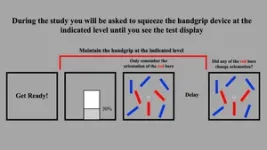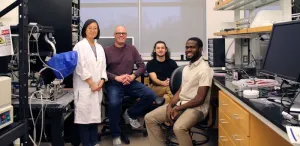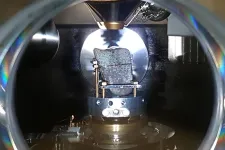(Press-News.org) RIVERSIDE, Calif. -- While engaged in a physical task requiring effort, such as driving a car or carrying grocery bags, older adults are more likely than younger adults to be distracted by items irrelevant to the task at hand, a University of California, Riverside, study reports.
The study assessed the interaction between physical exertion and short-term memory performance when distractors were present or absent in younger and older adults.
“Action and cognition, which interact often in daily life, are sensitive to the effects of aging,” said graduate student Lilian Azer, the first author of the research paper published in the journal Psychology and Aging. “Our study found that in comparison to younger adults, older adults are less likely to ignore distractors in their surroundings when simultaneously engaging in a cognitive task and an effortful physical task. Ignoring task-irrelevant items declines with age and this decline is greater when simultaneously performing a physical task — a frequent occurrence in daily life.”
According to Azer, the age-related differences may be amplified in situations where task demands are higher, such as having increased physical exertion or having more distractors.
The study tested what effects a simple physical action has on working memory and inhibitory control. Working memory, sometimes referred to as short-term memory, is a core cognitive process that maintains information while engaging in ongoing mental activities. Inhibitory control is the ability to ignore distracting information irrelevant to a task while focusing on task-relevant information.
The researchers recruited 19 older adults, aged 65-86 from local communities in Riverside, Calif., for the two-year study. Thirty-one younger adults, all between 18-28 years old, were recruited from UC Riverside psychology undergraduate courses and given course credit.
All participants were asked to grip a hand dynamometer, a kind of handgrip device, at either 5% or 30% of their strength while they performed a short-term memory task. A centrally located visual gauge provided real-time feedback on the exerted grip force; nearby, a memory array consisted of small blue and red orientation bars. The participants’ grip was the kind used when carrying a grocery bag, walking up a stairwell, or while driving.
Participants needed to focus on the red bars. The blue bars served as distractors – mimicking everyday distractions such as a vibrant billboard, a car honking, or an unrelated conversation. During the exercise with no distractors, they were shown three red bars momentarily and asked later to recall the bars’ orientation. With distractors, they were shown five blue bars as well and instructed to only remember the orientation of the red bars.
“We found that under high physical effort older adults were less likely to both ignore the distracting information and focus on the task-relevant information,” Azer said. “Our results suggest that older adults might have heightened distractibility.”
Starting in 2030, older Americans will make up 21% of the population, up from 15% in 2018. By 2060, nearly 25% of Americans will be 65 years and older.
Weiwei Zhang, who led the study and in whose lab Azer works, stressed the importance of understanding age-related declines in physical and mental functions along with their interaction. He explained that as we grow older, we may experience a reduction in muscle mass and strength, and declines in key cognitive processes — worse short-term memory, slower speed of processing information, and heightened distractibility — as a function of normal cognitive aging.
“It is important to understand that as we grow older, we may be more prone to distractors and this may be amplified during instances of simultaneous effortful physical action,” said Zhang, an associate professor of psychology and a member of UCR’s Aging Initiative. “Understanding how cognitive and physical actions interact can help us be more aware of how distracting information in our environment may impair our working memory.”
The decline in our ability to ignore distractors as we get older is a result of normal cognitive aging. The prefrontal cortex, a part of the cerebral cortex that has been implicated in remote memory consolidation, plays a role, and is typically involved in working memory and processes involving inhibitory control.
Azer explained that effortful mental or physical activities are essential for our everyday functioning. For example, while driving, we tend to hold the steering wheel with about 30% of our maximum physical strength. When we carry heavy shopping bags, we tend to hold use about 20% of our maximum physical strength.
“As we engage in these physical activities, very often we simultaneously engage in cognitive tasks where distractors — a billboard or a car sales commercial on the radio — may be present,” Azer said. “Inhibitory control may suffer during these concurrent tasks, making it more difficult, especially for older adults, to ignore the distractors and focus on task-relevant information. Since it is rare that we perform a physical or cognitive task in complete isolation, it is important to minimize distractions. If this is not possible, we need to be aware that the effortful physical task may impair our ability to both perform a working memory task and successfully ignore surrounding distracting information.”
Next, the research team plans to further investigate the impact of effortful physical action on cognitive function.
“We would like to understand the role of arousal induced by physical effort and how this arousal can impact response time and inhibitory control,” Azer said.
Azer and Zhang were joined in the study by Hyung-Bum Park of UCR and Weizhen Xie of the National Institute of Neurological Disorders and Stroke of the National Institutes of Health. Azer expects to graduate in June 2023 with a doctoral degree in psychology, focusing on cognition and cognitive neuroscience.
The study was supported by grants from the National Institute of Mental Health, National Institute on Aging, and National Institute of Neurological Disorders and Stroke.
The title of the paper is “Detrimental Effects of Effortful Physical Exertion on a Working Memory Dual-Task in Older Adults.”
The University of California, Riverside is a doctoral research university, a living laboratory for groundbreaking exploration of issues critical to Inland Southern California, the state and communities around the world. Reflecting California's diverse culture, UCR's enrollment is more than 26,000 students. The campus opened a medical school in 2013 and has reached the heart of the Coachella Valley by way of the UCR Palm Desert Center. The campus has an annual impact of more than $2.7 billion on the U.S. economy. To learn more, visit www.ucr.edu.
END
Older adults are more easily distracted, study reports
Finding highlights age-related declines in short-term memory, cognitive control
2023-05-10
ELSE PRESS RELEASES FROM THIS DATE:
Texas A&M Institute for Advancing Health through Agriculture seeks experts to support study on responsive agriculture
2023-05-10
College Station, Texas (May 10, 2023) – Texas A&M’s Institute for Advancing Health Through Agriculture (IHA) is spearheading a study that focuses on advancing the concept of responsive agriculture and is seeking experts and leaders in the agriculture-food value chain to serve one of its three committees. The committees, along with a recently named Task Force, will help develop a road map to achieve responsive agriculture, an agricultural system and food environment that supports health ...
How does the brain interpret taste?
2023-05-10
NORMAN, OKLA. – Taste is a complex neurological experience that has the potential to provide extensive, and perhaps surprising, information on how the brain makes sense of sensations and the organization of brain pathways. A research project funded by the National Institutes of Health, led by Christian H. Lemon, Ph.D., an associate professor in the Department of Biology in the Dodge Family College of Arts and Sciences, aims to better understand how the brain processes taste and how those neural pathways can evolve.
Taste ...
ACM and CSTA announce 2022-2023 Cutler-Bell student winners
2023-05-10
The Association for Computing Machinery (ACM) and the Computer Science Teachers Association (CSTA) announced four high school students were selected from among a pool of graduating high school seniors throughout the US for the ACM/CSTA Cutler-Bell Prize in High School Computing. Eligible students applied for the award by submitting a project/artifact that engages modern technology and computer science. A panel of judges selected the recipients based on the ingenuity, complexity, relevancy, and originality of their projects.
The Cutler-Bell Prize promotes ...
Abdominal aortic aneurysm: new treatment may reduce size; COVID infection may speed growth
2023-05-10
Research Highlights
Abdominal aortic aneurysm, a weakening and ballooning of the aorta, the largest blood vessel in the body, may result in a life-threatening rupture.
In a small, preliminary study examining a potential treatment to keep small abdominal aortic aneurysms from growing to a dangerous size, intravenous administration of immune-modulating cells resulted in a significant decrease in pro-inflammatory cells, and with higher doses, there was a decrease in aneurysm size.
In a separate small study, people with abdominal aortic aneurysms ...
Detecting neutrinos from nuclear reactors with water
2023-05-10
The Science
Neutrinos are subatomic particles that interact with matter extremely weakly. They are produced in many types of radioactive decays, including in the core of the Sun and in nuclear reactors. Neutrinos are also impossible to block—they easily travel from the core of a nuclear reactor to a detector far away, and even through the Earth itself. Detecting the tiny signals from neutrinos therefore requires huge devices that are extremely sensitive. The SNO+ experiment has just shown that a detector filled with simple water can still detect reactor neutrinos, even though the neutrinos create only tiny signals in the detector.
The ...
When A.I. discloses personal information, users may empathize more
2023-05-10
In a new study, participants showed more empathy for an online anthropomorphic artificial intelligence (A.I.) agent when it seemed to disclose personal information about itself while chatting with participants. Takahiro Tsumura of The Graduate University for Advanced Studies, SOKENDAI in Tokyo, Japan, and Seiji Yamada of the National Institute of Informatics, also in Tokyo, present these findings in the open-access journal PLOS ONE on May 10, 2023.
The use of A.I. in daily life is increasing, raising interest in factors that might contribute to the level of trust and acceptance people feel towards A.I. agents. Prior research has suggested that people are ...
Bird and bat deaths at wind turbines increase during species’ seasonal migrations
2023-05-10
Bird and bat fatalities at wind turbines increase during seasonal migrations – information which could aid their protection, according to a study published May 10, 2023 in the open-access journal PLOS ONE by John D. Lloyd from the Renewable Energy Wildlife Institute of Washington DC, USA, and colleagues.
While there have been local and regional studies on bird and bat deaths caused by wind turbines, this study looks at data from 248 wind turbine facilities across the United States—almost 30 percent ...
Copper artefacts reveal changing connections in prehistoric Europe
2023-05-10
The geochemistry of copper artefacts reveals changes in distribution networks across prehistoric Europe, according to a study published May 10, 2023 in the open-access journal PLOS ONE by Jan Piet Brozio of Kiel University, Germany and colleagues.
Early copper artefacts are considered to have a high cultural and historical significance in European prehistory, but limited information exists about how copper was used and distributed in Neolithic Europe. In this study, the authors analyzed 45 copper objects, including axes, chisels, and other items, from various sites dating to the 4th and 3rd millennia BC of Northern Central Europe and Southern ...
Pregnant and lactating dogs share patterns of some blood metabolites - including glucose and fatty acid concentrations - with pregnant women, according to study of 27 dogs representing 21 breeds
2023-05-10
Article URL: https://journals.plos.org/plosone/article?id=10.1371/journal.pone.0284570
Article Title: Metabolomics during canine pregnancy and lactation
Author Countries: Switzerland, Germany, Finland
Funding: The costs were covered by the Freie Universitaet Berlin (examination, sampling) without any specific funding and PetBiomics Ltd provided material support (Analyses). PetBiomics Ltd employee Claudia Ottka and PetBiomics Ltd chairman Hannes Lohi were involved in the analysis and the preparation of the manuscript. The funders had no role in study design, data collection and decision to publish. END ...
Australian bushfires likely contributed to multiyear La Niña
2023-05-10
The catastrophic Australian bushfires in 2019-2020 contributed to ocean cooling thousands of miles away, ultimately nudging the Tropical Pacific into a rare multi-year La Niña event that dissipated only recently.
The research was led by the National Center for Atmospheric Research (NCAR) and in Science Advances.
La Niña events tend to impact the winter climate over North America, causing drier and warmer than average conditions in the southwest U.S., wetter weather in the Pacific Northwest, and colder temperatures in Canada and the northern U.S. Because the emergence of La Niña can ...
LAST 30 PRESS RELEASES:
Numbers in our sights affect how we perceive space
SIMJ announces global collaborative book project in commemoration of its 75th anniversary
Air pollution exposure and birth weight
Obstructive sleep apnea risk and mental health conditions among older adults
How talking slows eye movements behind the wheel
The Ceramic Society of Japan’s Oxoate Ceramics Research Association launches new international book project
Heart-brain connection: international study reveals the role of the vagus nerve in keeping the heart young
Researchers identify Rb1 as a predictive biomarker for a new therapeutic strategy in some breast cancers
Survey reveals ethical gaps slowing AI adoption in pediatric surgery
Stimulant ADHD medications work differently than thought
AI overestimates how smart people are, according to HSE economists
HSE researchers create genome-wide map of quadruplexes
Scientists boost cell "powerhouses" to burn more calories
Automatic label checking: The missing step in making reliable medical AI
Low daily alcohol intake linked to 50% heightened mouth cancer risk in India
American Meteorological Society announces Rick Spinrad as 2026 President-Elect
Biomass-based carbon capture spotlighted in newly released global climate webinar recording
Illuminating invisible nano pollutants: advanced bioimaging tracks the full journey of emerging nanoscale contaminants in living systems
How does age affect recovery from spinal cord injury?
Novel AI tool offers prognosis for patients with head and neck cancer
Fathers’ microplastic exposure tied to their children’s metabolic problems
Research validates laboratory model for studying high-grade serous ovarian cancer
SIR 2026 delivers transformative breakthroughs in minimally invasive medicine to improve patient care
Stem Cell Reports most downloaded papers of 2025 highlight the breadth and impact of stem cell research
Oxford-led study estimates NHS spends around 3% of its primary and secondary care budget on the health impacts of heat and cold in England
A researcher’s long quest leads to a smart composite breakthrough
Urban wild bees act as “microbial sensors” of city health.
New study finds where you live affects recovery after a hip fracture
Forecasting the impact of fully automated vehicle adoption on US road traffic injuries
Alcohol-related hospitalizations from 2016 to 2022
[Press-News.org] Older adults are more easily distracted, study reportsFinding highlights age-related declines in short-term memory, cognitive control








